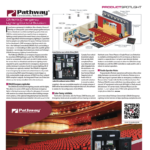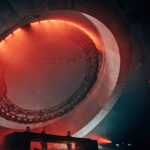The idea of curving video walls is nothing new. I have watched as video crews spend countless hours trying to rig straight pieces of video tiles at angles, usually in a vain attempt to get a seamless, curved video wall. Techs spent the day messing around with this game of millimeters by using rulers, changing rigging, nudging pieces a hair, adding clamps, and eventually they would kind of achieve what they were looking for. Now I’m not saying this was bad, but I always wondered why there wasn’t an easy way to do this. Couldn’t someone physically engineer a product to do this without the rigmarole? Well, apparently so.
PixelFlex lived up to its name last year by creating what just may be the most versatile LED product on the market, the FLEXcurve LED tile. The unique way they designed the individual panels to bend at your desired angle is so easy to work with I can’t help but wonder where they have been all my life. The simplicity of the concept, backed by the rock solid physical structure that holds each LED tile in place, is a thing of beauty to a designer as well as a technician. The user is guaranteed to have a perfect seamless picture, whether the wall is hung in a convex, concave or wave form.
The Cabinet
The basic tile is a 30-inch square of high resolution LEDs mounted in a cabinet. When hung as a standard straight tile, it takes up less than 6 inches of depth. Now if you look at the top of the tile (Fig. 1), you will see that it is divided into three pieces via two hinges. The center 15 inches of each tile is flat, but the 7.5-inch section on either side of it can bend at the hinge. One can easily adjust the angle on each hinge up to 10° in either direction through the angle settings visible on the top and simply locking them in place with two thumb tabs. Think of a protractor you may have used in geometry class that has visible lines showing the desired angles. By setting all the angles the same on each cabinet and butting them up to each other, one can easily have a rounded video surface that is uniform and seamless. Every 15 inches, there will be a subtle curve in the video.
By bending the tile in either direction, one can make the entire surface convex or concave. If you wished to be artsy, you could form a wave out of the tiles as well.
![]()
The LEDs themselves are mounted in a strong aluminum frame. This slim, heavy-duty casing protects the tiles in transit and keeps the entire wall looking rigid and seamless when hanging. The FLEXcurve is manufactured in 4mm, 6mm, 8mm, 10mm and 12mm models, and they are rated for outdoor as well as indoor use. You also, of course, have the option to use the panels in a flat screen configuration if you wish.
The tiles are extremely bright (6000 NIT), and in most cases, they will run at 30 to 50 percent of their capable brightness. The product’s road crew-friendly design includes spring-loaded screws that are attached to the panel so you do not have to worry about losing screws while climbing a wall. The modules are also hot swappable.
The Hang
PixelFlex has kept it simple. They have a single hanging bracket that is made of heavy gauge aluminum. It uses two cheeseboro clamps to attach to a truss or batten with a single rod that extends down and snaps into the top cabinet. This bracket can support the weight of 16 vertical tiles, enough to create a 40-foot-high video wall. Each module weighs less than 40 pounds, and each also comes equipped with easy-to-grab handles on the back.
The FLEXcurve has a sturdy quick release mechanism that makes it simple for one person to just walk down the line and snap them into place. The tiles connect sideways with the use a simple T-shaped Allen key (hex wrench), and guide pins help crew members align the LEDs with precision.
The Connection
![]() The tiles are easily addressed and daisy-chained together with the use of a Neutrik True1 and powerCON locking connectors to be used for signal and power. Slim rack mounted LED External sending boxes feed the signal from backstage to the units. No matter which direction you hang these in, the design allows the user to easily replace a single module through either the front or the back. For quick testing, either in the shop or before you fly your wall to trim, each module has its own hard preview button on the back. One can press this button without any signal being present to check the RGB on the tile. Sturdy flight cases are available in four colors, and each can hold four cabinets.
The tiles are easily addressed and daisy-chained together with the use of a Neutrik True1 and powerCON locking connectors to be used for signal and power. Slim rack mounted LED External sending boxes feed the signal from backstage to the units. No matter which direction you hang these in, the design allows the user to easily replace a single module through either the front or the back. For quick testing, either in the shop or before you fly your wall to trim, each module has its own hard preview button on the back. One can press this button without any signal being present to check the RGB on the tile. Sturdy flight cases are available in four colors, and each can hold four cabinets.
PixelFlex’s FLEXcurve units are ideal for touring as well as one-offs. They can be seen on Luke Bryan’s current tour and have been utilized on other high profile shows, such as the 2014 Dove Awards staged by the Gospel Music Association in Nashville.
The weight of each full case is an acceptable 400 pounds, and for efficient transport, they can stack two high inside a truck. The quickest way to assemble FLEXcurve displays is to take a team approach, but if you had to, you could assemble a whole wall all by yourself.
At a Glance
Sleek and Smooth
When I first saw these hanging in the air at LDI, I could swear each tile was physically curved. There was absolutely no recognition of any angles to my eyes from 30 feet away. Easy to see why this product, which debuted in late 2013, received a Parnelli Award for Indispensible Technology in the video category for 2014. —N.S.
PROS
Easily-adjustable curve angles per panel. Handles accelerate quick rig and clip assembly of lightweight panels. Very bright. Easy to maintain on the road.
CONS
None
![]()
STATS
Price This product is available for rent as well as purchase. Please contact PixelFlex directly for all pricing.
Manufacturer PixelFlex
More Info pixelflexled.com


